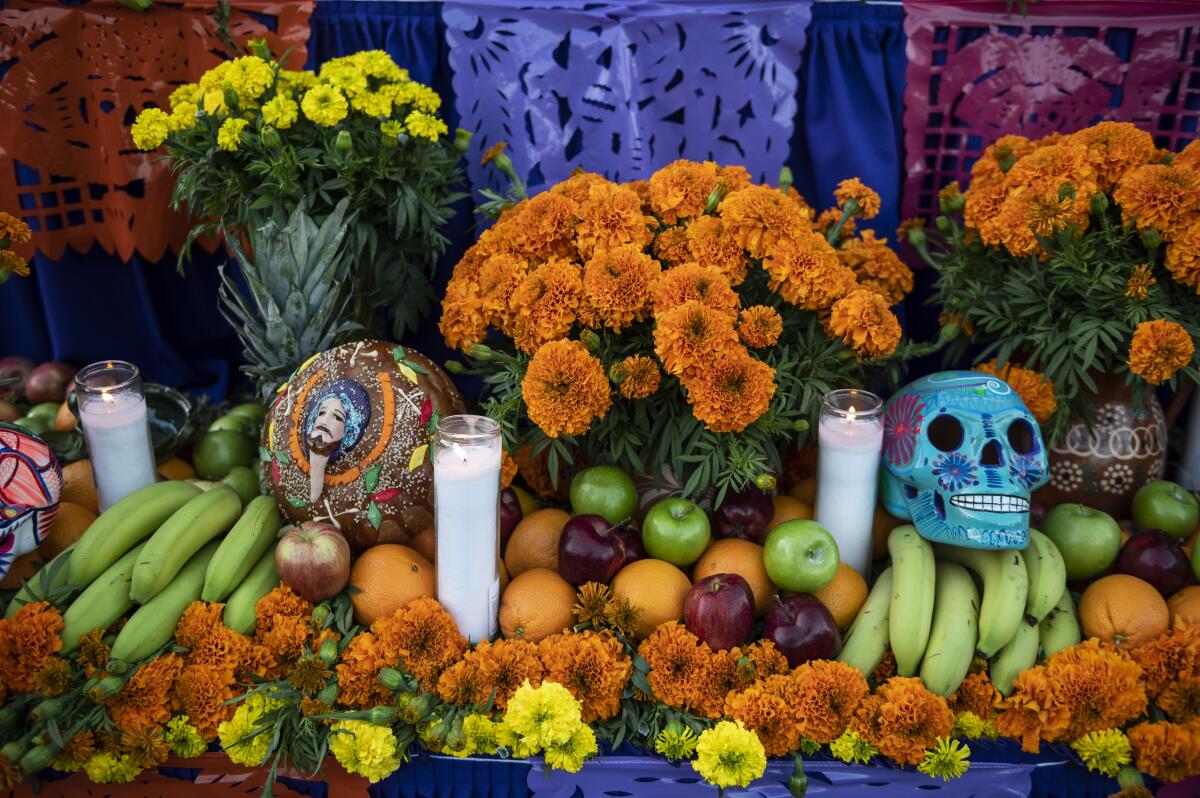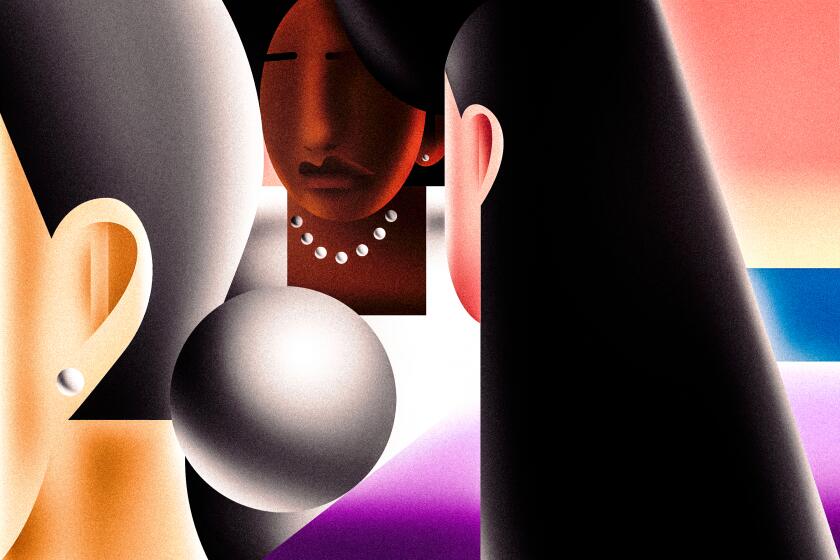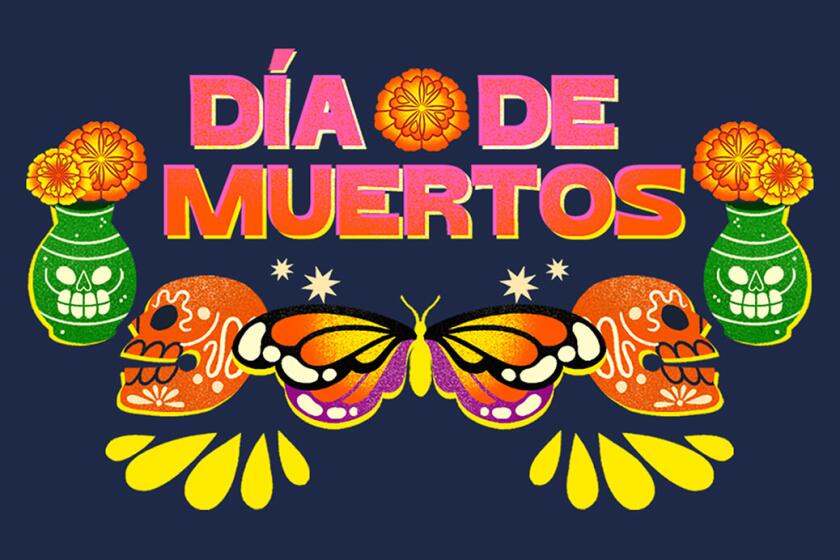Día de Muertos used to scare me. Now I appreciate a holiday when the living commune with the dead

- Share via
I grew up afraid of ghosts.
The elders in my Mexican family welcomed the dead, but they observed Día de Muertos quietly. My grandmother made a small ofrenda at her home in San Diego (with candles, flowers and framed black-and-white photos of her deceased parents and brother) and took cempasuchil flowers to her relatives’ graves in Tijuana.
As she communed with spirits, I and her other U.S.-born grandchildren shuddered at the thought of warty ghouls and spooky ghosts. We drank atole and ate pan de muertos, but we were distracted by Halloween. We thought the creatures of Tim Burton’s “The Nightmare Before Christmas” would spill out into the streets. For us, the holiday was about keeping phantoms at bay, not bonding with them. (Of course, it was also an excuse to trick-or-treat in costume and gorge on candy.)
Opinion Columnist
Jean Guerrero
Jean Guerrero is the author, most recently, of “Hatemonger: Stephen Miller, Donald Trump and the White Nationalist Agenda.”
Today’s children are lucky. They can’t ignore Día de Muertos, which has entered popular culture thanks to Disney/Pixar’s “Coco,” massive festivities, community altars and class projects based on the Mexican holiday. The tradition, which has roots in ancient Indigenous civilizations and Catholic customs, tells us that from Oct. 31 to Nov. 2, the boundary between the spirit world and the living world temporarily dissolves, allowing our ancestors to come visit us.
Unfortunately, like many Latinos raised in an anti-Mexican 1990s California, I grew up ruptured from my family history. It wasn’t until I was an adult that I understood the downsides of missing out on a holiday that nurtures a dialogue between the living and the dead.
“When you know where you come from, you’re stronger,” Norma Iglesias-Prieto, a professor of Chicano studies at San Diego State, told me. “When you know where you come from, you can try to avoid the mistakes of the past.”
It’s a Muertos lesson for all Americans, many of whom refuse to reckon with their full history.
Ofrendas used to celebrate Día de los Muertos are made using items that have special meanings with origins dating back to Indigenous people.
“Una sociedad sin historia es una sociedad muerta,” Iglesias-Prieto said, warning in Spanish that a society without history is a dead society. She organizes a community altar for Día de Muertos.
Día de Muertos used to be celebrated more privately among immigrant families in the U.S. They carried on the tradition as my abuelita did: making ofrendas and visiting cemeteries. But in the 1970s, Chicano artists began organizing more public celebrations, including large community altars and processions. “It was a reclamation of culture but also a reclamation of public space,” Roberto Hernandez, associate professor of Chicano studies at San Diego State, says.
As the holiday became widely seen and embraced, it was also commercialized. Today, it inspires corporate-sponsored music festivals, mass-produced Halloween costumes, children’s toys, hipster decor and other merchandise sold in stores across the country.
But commercialization can’t erase the holiday’s core message: that we are all interconnected. “The dead contribute to the living and continue to contribute to this world as much as we contribute to the world of the dead,” Hernandez told me.
Racial identity is as personal as it is a product of how we’re seen. But what is obvious to me about my Latino relatives is not how many of them see themselves.
When I moved to Mexico City in October 2010 for my first job as a journalist, public spaces were colorful with the iconography of death, including skull masks and towering calavera sculptures. It felt like an invitation to learn about my ancestors.
For the four years that I lived in Mexico, I researched my family history while also witnessing the role of U.S. guns, foreign policy and corporate colonialism in the violence, poverty and corruption that I’d been taught to associate with Mexicans. Everywhere I looked, there was evidence of our inescapable interconnectedness.
I discovered that my great-grandfather Antonio began crossing into the U.S. in the early 1900s after U.S. investors took over Mexico’s most fertile land and resources. He worked as a bracero in the U.S., and he developed a drinking problem that got him into trouble at times, including a prison sentence prior to his deportation. I recorded his and other ancestors’ stories in my first book.
The holiday is an opportunity to spend time with the memories of those who came before us, and celebrate life.
Today, several of my ancestors’ black-and-white photos appear on a square piece of wood I’ve hung over a shelf that I’ve adapted for my first-ever ofrenda, with cempasuchil and floating candles in cups of water.
I was inspired to make it after my Puerto Rican mother sent me a photo of an ofrenda she made this year for the spirits of her father and brother. The Mexican tradition spoke to her after decades in California, with its strong Mexican culture.
I never made an ofrenda while living in Mexico or in the years since returning to the U.S. because I’d never embraced it as a child or cultivated the skill of ghost whispering. But if non-Hispanic Americans are dressing up as calaveras and attending Muertos concerts, I realized, I could make an ofrenda for my ancestors.
For my great-grandmother Maria de Jesus, a devoted Catholic, I set out a small Virgin Mary sculpture filled with holy water. For my great-grandfather Antonio, I included only a few drops of mezcal (I don’t want to encourage his bad habits). When I placed the shot glass with its smoky aroma on the altar, my great-grandpa looked pleased in his mugshot. I’m still gathering offerings for my other ancestors, such as Old Spice cologne for my grandfather Luis.
I like to imagine that whenever I summon my ancestors’ names and faces, they watch over me and help me avoid the pitfalls that some experienced, while reinforcing the resilience I inherited from the best of them.
Now, on Día de Muertos, I’ll thank them all for their guidance.
More to Read
A cure for the common opinion
Get thought-provoking perspectives with our weekly newsletter.
You may occasionally receive promotional content from the Los Angeles Times.














